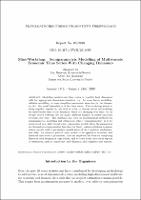Zusammenfassung
Modelling multivariate time series of possibly high dimension calls for appropriate dimension-reduction, e.g. by some factor modelling, additive modelling, or some simplified parametric structure for the dynamics (i.e. the serial dependence) of the time series. This workshop aimed to bring together experts in this field in order to discuss recent methodology for multivariate time series dynamics which are changing over time: by an abrupt switch between two (or more) different regimes or rather smoothly evolving over time. The emphasis has been on mathematical methods for semiparametric modelling and estimation, where ”semiparametric” is to be understood in a rather broad sense: parametric models where the parameters are themselves nonparametric functions (of time), regime-switching nonparametric
models with a parametric specification of the transition mechanism, and alike. An ultimate goal of these models to be applied to economic and financial time series is prediction. Another emphasis has been on comparing Bayesian with frequentist approaches, and to cover both theoretical aspects of estimation, such as consistency and efficiency, and computational aspects.

